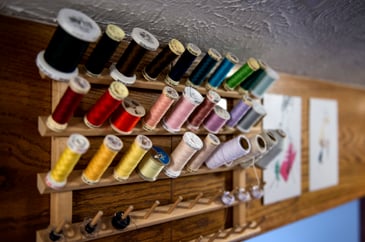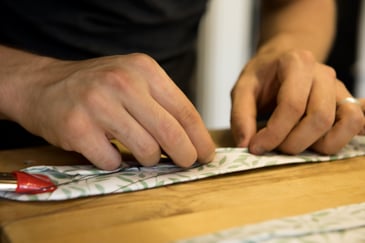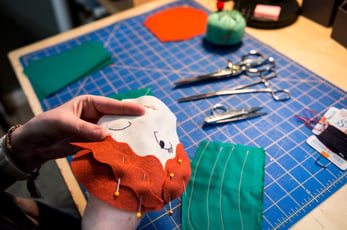 With all the information available online today, we can learn to do almost anything if we start with a quick search on any device. So many modern makers have turned to the internet to to learn how to sew, or even just to learn how to sew better. Online resources are a huge part of their learning process, even though it takes practice to truly master the craft. Through our interviews and focus groups with makers who sew, we've found that online sewing tutorials are as useful for beginners learning the basics as they are for experts who want to learn a new skill or solve a specific problem. In all these cases, sewists turn to both their fellow makers and the brands they trust for the "how to" answers they need.
With all the information available online today, we can learn to do almost anything if we start with a quick search on any device. So many modern makers have turned to the internet to to learn how to sew, or even just to learn how to sew better. Online resources are a huge part of their learning process, even though it takes practice to truly master the craft. Through our interviews and focus groups with makers who sew, we've found that online sewing tutorials are as useful for beginners learning the basics as they are for experts who want to learn a new skill or solve a specific problem. In all these cases, sewists turn to both their fellow makers and the brands they trust for the "how to" answers they need.
But when there are so many different sewing tutorials out there for million of different projects, how can you make sure that your content stands out from the rest (and keeps sewists coming back for more)? In this post, we're discussing the top 3 elements sewists told us that they're actually looking for in a good sewing tutorial.
3 Important Elements Your Sewing Tutorials Should All Have
Sewing tutorials can come in several different formats, but the most popular tutorials today are usually packaged as video walkthroughs or blog post/pdf how-tos containing directions and images. Whatever type of tutorial you're creating, here are the most important elements it should incorporate:
- Brief and narrow topics: The makers we've interviewed had a common complaint about the general broadness and length of many tutorials out there. Makers today need the exact answer to the specific questions they're asking. They don't want to sift through a long tutorial that covers a variety of topics all at once. Focus your tutorials on one narrow topic or demonstration and keep it short and concise. Breaking up your content this way allows makers to find the tutorials that are most relevant to their skill level and specific challenges.
 Close up shots: Sewists need to be able to visualize the instructions you're giving them, and the best way to illustrate processes and techniques is by showing each step up close. Sewists we've interviewed have told us that if the camera is too far away from the project or the hands doing the demonstrating, they can't replicate what the tutorial is explaining.
Close up shots: Sewists need to be able to visualize the instructions you're giving them, and the best way to illustrate processes and techniques is by showing each step up close. Sewists we've interviewed have told us that if the camera is too far away from the project or the hands doing the demonstrating, they can't replicate what the tutorial is explaining.- Production quality: While your tutorials don't have to have a blockbuster set or budget, they do need to be clean and in-focus in order to be of true value to today's sewists. Making sure your image and/or audio quality is clear and easy to understand might seem like a small task, but this element may actually make the biggest difference to sewists! It's hard to learn with distractions like fuzzy images, messy setups, and background noise getting in the way, so make sure your final product is as professional as possible.
Creating Sewing Tutorials Makers Value
 Online content is perhaps the most common way today's sewists learn more about their craft. If your brand is looking to connect with these passionate makers, but your online presence is a little lacking, posting tutorials that address common challenges in the craft is a great way to start reaching out to your target audience. Keeping in mind that all sewists are looking for clarity, visibility, and quality when it comes to your tutorial posts and videos, something you should also remember is that your content needs to add value to your audience's process; it should never just be fluff.
Online content is perhaps the most common way today's sewists learn more about their craft. If your brand is looking to connect with these passionate makers, but your online presence is a little lacking, posting tutorials that address common challenges in the craft is a great way to start reaching out to your target audience. Keeping in mind that all sewists are looking for clarity, visibility, and quality when it comes to your tutorial posts and videos, something you should also remember is that your content needs to add value to your audience's process; it should never just be fluff.
Any tutorial that comes across as more of a thinly-veiled product advertisement isn't going to hit the mark for most makers when they're just trying to troubleshoot a problem. While you can definitely use and promote your products within tutorial content, the primary focus of the post or video should be education, not marketing. When you set out to genuinely help makers in your area of expertise, you'll start to build your brand's expert power and reputation as a trustworthy resource for sewists. And if all goes to plan, fans of your content are likely to turn into loyal customers who promote your brand within their own networks. In the end, your sewing tutorials can benefit both your own business as well as the customers your serve if you create the very best content you can.




